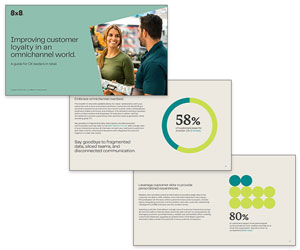Tricia Morris at 8×8 explains eight eye-opening customer service statistics that show changing customer expectations.
Data from the Brookings Institute shows that spending on services is almost twice as much as spending on products.
This growth in the value of services has brought with it a growth in the value of the surrounding customer service.
Consumers see a service, such as healthcare, as valuable, and they naturally demand equal value from the customer services that support it, such as online bookings and rescheduling, telehealth calls, and in-app live chats.
While the value of customer service grows, what customers expect is always changing depending on generational, economic, and technological trends.
With that in mind, here are eight statistics that show the ongoing changes in customer service expectations and what they mean for businesses:
1. Omnichannel is booming, as 88% of customer service journeys that begin in self-service now touch several channels.
As preferences for channels change with generations, industries, and the cause of the customer query, it’s key that organizations have the full range of channels to meet every customer, wherever they are, and however they want to interact.
2. Self-service is a priority for younger generations. Research from Gartner shows that 38% of Gen Z and millennials will abandon a query or attempt to resolve a customer service issue if an organization does not offer self-service channels.
This “self-service or no service” mindset is set to shape markets as Gen Z and younger millennials age. Already 52% report they wouldn’t buy from a company if it couldn’t resolve their issue in self-service.
3. Organizations can excel if they overcome difficult channel transitions. Data shows that 93% of customers return higher customer satisfaction scores (CSAT) when the move between channels is seamless.
Alongside this, mastering the switch between self-service and assisted channels will free up agent time, as 74% of customers who experience seamless transitions will return to self-service.
4. Most customer experiences are lackluster, leaving customers wanting more. The latest Ipsos CX report highlights that 47% of customers report their experiences as being “nothing notable,” meaning they are forgettable or indifferent.
Fewer than half of experiences (42%) deliver something positive that pleases or delights the customer in some way, according to the report.
And unfortunately, according to Gartner, almost two-thirds (62%) of customer service channel shifts are currently considered “high effort” for customers.
5. There is a gap between perception and performance as many organizations overestimate their CX performance.
One-third of organizations rate their own performance as excellent (over 90% satisfaction), and 45% rate it as good (80-90% satisfaction).
The CX performance gap is “troubling,” as Beth Schultz, VP of Research and Principal Analyst at Metrigy, says, as it means “many businesses may not recognize their CX failures.”
6. People have lower expectations of social media channels, but it is also the touchpoint that exceeds their expectations most.
Almost two-fifths of customers say that an organization’s social media channels exceeded their expectations for customer service.
This is great news for organizations that have a strong social media presence combined with social channel chat functionality and customer service tools.
7. Customer experience is set to become the biggest differentiator over the next six years.
Surveying CX and IT leaders, 8×8 found that the majority (46%) believe that customer experience will be the biggest differentiator by 2030.
That means all of the changes in customer service mentioned above will become even more important in determining how your organization stands out from the competition.
8. Staying ahead of trends is more important than keeping up as 50% of consumers will actively change brands if a company doesn’t anticipate their needs.
Not only does this mean the above trends are important, but keeping up with new ones, including the increasing use of conversational AI, are integral too.
Customer service—under the broader ‘services’ umbrella—will continue to be a huge consideration when it comes to customer acquisition and retention.
This blog post has been re-published by kind permission of 8x8 – View the Original Article
For more information about 8x8 - visit the 8x8 Website
Call Centre Helper is not responsible for the content of these guest blog posts. The opinions expressed in this article are those of the author, and do not necessarily reflect those of Call Centre Helper.
Author: 8x8
Published On: 12th Feb 2024 - Last modified: 6th Dec 2024
Read more about - Guest Blogs, 8x8






 8x8 is transforming the future of business communications as a leading Software-as-a-Service provider of voice, video, chat, contact centre, and enterprise-class API solutions, powered by one global cloud communications platform.
8x8 is transforming the future of business communications as a leading Software-as-a-Service provider of voice, video, chat, contact centre, and enterprise-class API solutions, powered by one global cloud communications platform. 
































